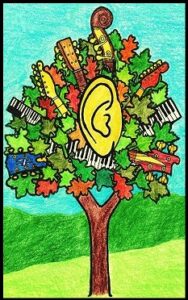 Most people think that ear-training has to do with perfect pitch. They think that you need perfect pitch for ear-training, or for picking chords and melodies out by ear, but that isn’t true. It’s important to understand the difference between perfect pitch and relative pitch.
Most people think that ear-training has to do with perfect pitch. They think that you need perfect pitch for ear-training, or for picking chords and melodies out by ear, but that isn’t true. It’s important to understand the difference between perfect pitch and relative pitch.
“Perfect pitch” is the ability to hear a note and identify the note name without using an instrument for reference. You don’t need perfect pitch to play by ear. The two concepts overlap, but ear-training isn’t the same thing as perfect pitch. Perfect pitch is sometimes a temporary by-product of developing relative pitch. Other than that, there’s no reason to try to develop perfect pitch.
“Relative pitch” is the ability to identify the distances between notes. “Relative pitch” is a relative term. At a basic level, relative pitch is simply the ability to hear melody and harmony in terms of a 12-note scale. This means you can recognize a melody, and follow it when it transposes to another key. If you don’t understand what that means, don’t worry. It’s a natural, intuitive ability. As a casual listener, you probably have this basic level of relative pitch. Otherwise you probably wouldn’t bother to listen to music.
The purpose of ear-training is to develop a good sense of relative pitch. The easiest, most intuitive way to develop your relative pitch is to simply pick out melodies and chords by ear, one note or one chord at a time. You don’t need a system or a plan. Learning to pick out parts is an important first step to feeling like you “own” the music you play.
If you know the one-to-one correspondences between note names and the number system, then you can use relative pitch at an advanced level. First, you can learn to identify notes by calculating the intervals between notes. This starts with learning to identify the intervals between pairs of notes, like major 3rd, or perfect 5th. Second, if you also have a reference pitch from an instrument, then you can calculate note distances by comparing them to that pitch, which allows you to name individual notes.
The note/number system is really not that complicated. It just takes practice to get accustomed to using it. If you really know your keyboard or fretboard, then you have a mental model that can help you figure out intervals. Keep that in mind when we talk later about mentally practicing your instrument.
To the outside observer, relative pitch looks like the same thing as perfect pitch. It’s possible to memorize a reference pitch, at least temporarily. If you understand relative pitch formally, then you actually have “perfect pitch” for as long as you can keep a reference pitch in mind for comparison. When I was in orchestra class for an hour a day, five days a week during middle school and high school, I had perfect pitch for days or weeks at a time. For a while, I could recall A440 perfectly.
Rick Beato maintains that children can acquire perfect pitch during the ages when they’re acquiring language. That’s about age 6 and younger. I would be skeptical of this, but Rick’s children are remarkably adept at naming intervals and note names by ear. He says his children developed perfect pitch because of early exposure, so I have no reason to doubt him. Rick Beato has four videos on perfect pitch. See: Rick Beato’s video: Why Adults Can’t Develop Perfect Pitch.
Even perfect pitch is relative. It’s precise enough for distinguishing one note from another, but probably not for tuning. Tuning an instrument usually involves comparing two pitches played together. For instance, it probably isn’t possible to tune a piano using only perfect pitch.
Let me emphasize again that you don’t need perfect pitch to play by ear. It’s a common misconception that playing by ear and perfect pitch go together. They can, but in real life they usually don’t. You might think that playing by ear means using perfect pitch to identify individual notes, and then finding those notes on the fretboard or keyboard. That idea is intuitive, but it’s wrong.
Playing by ear is not a process of naming individual notes. The real mental process of playing by ear has to do with identifying the distances between notes, regardless of what those notes are. This is how people naturally understand music. The concept of distances between notes is one of the most important in music. It comes up again and again in relation to all sorts of other topics, like seeing shapes on the fretboard.
© 2019, 2020 by Gregory Varhaug